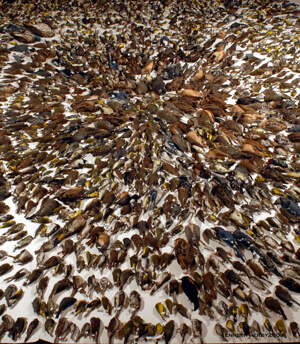Leading National Bird Organization Calls for NFL Commitment to Reduce Bird Mortality at New Vikings Stadium
 |
| The Cooper's Hawk is one of many bird species killed by collisions with glass. |
(Washington, D.C., July 30, 2014) American Bird Conservancy (ABC), one of the nation's leading bird conservation organizations, has asked National Football League (NFL) officials in Washington, D.C., to modify plans for the soon-to-be-built Minnesota Vikings Stadium in Minneapolis, which features expanses of glass expected to kill thousands of birds over time.
ABC asked for a meeting with the NFL via a July 29, 2014 letter to NFL Commissioner Roger Goodell. The request comes after the refusal of the Minnesota Vikings and the Minnesota Sports Facilities Authority to invest about one-tenth of one percent of the stadium cost to make the recommended adjustments to the installation.
“There is very little doubt that this new stadium will be a bird-killer,” said Dr. Christine Sheppard, an internationally recognized leader on the issue of bird collisions with buildings. Dr. Sheppard heads the only national collisions campaign program in the United States. “The NFL clearly derives huge benefits from the marketing of inspirational birds such as eagles (Philadelphia), falcons (Atlanta), seahawks (Seattle), ravens (Baltimore), and cardinals (Arizona). We think it's a travesty to use birds to advance your brand and then kill them over what amounts to pocket change for your organization,” she said.
The ABC letter expressed concern that “… the new Vikings stadium plans to have a large glass wall exterior that will cause the avoidable and unnecessary deaths of birds legally protected by federal law.” In addition, the letter suggests steps be taken to reduce bird mortality at stadiums in Los Angeles, Atlanta, and San Diego in addition to Minneapolis.
The new Vikings stadium is expected to open in two years and cost nearly one billion dollars. Changes in the glass design to substantially reduce the risk of deadly bird collisions would cost only about $1.1 million.
“Much of the world is demanding more wildlife-friendly products, and a big part of that is bird-friendly technology,” said Sheppard. “Bird collision mortality is certainly a contributing factor to the unfortunate reality that we now have over 200 species of birds suffering population declines or in serious trouble.”
Sheppard says that the state-wide bird conservation group, Minnesota Audubon, has been attempting to convince stadium owners to make changes to reduce bird collisions since early in the design phase. The most important change, she says, would be to use bird-friendly glass that has low reflectivity on the outside and a pattern of ceramic dots or “frit” that, while not impeding the view through the glass for people, would act as a deterrent to birds. Birds will otherwise likely see the glass as an open flyway and fatally crash into it at speeds of up to 40 miles per hour.
 |
Sampling of birds killed after colliding with buildings over a 12-month period in Toronto. Photo: Kenneth Herdy, FLAP |
The issue of fatal bird collisions gained national attention in recent months following release of the most comprehensive study of its kind. The peer-reviewed study, “Bird–building Collisions in the United States: Estimates of Annual Mortality and Species Vulnerability," was authored by federal scientists at the Smithsonian Conservation Biology Institute and the U.S. Fish and Wildlife Service. It found that between 365 and 988 million birds are likely killed in the United States each year as a result of collisions with buildings.
The study provides quantitative evidence to support the conclusion that building collisions are second only to feral and free-ranging pet cats (estimated to kill as many as 3 billion birds each year) as the largest source of direct human-caused mortality for U.S. birds.
Sheppard authored the widely used publication Bird-Friendly Building Design (available at collisions.abcbirds.org), which provides comprehensive solutions to reduce bird mortality from building collisions. The 58-page publication focuses on both the causes of collisions and the solutions, with a comprehensive appendix on the biological science behind the issue. She was a leader in the successful passing of bird-friendly building codes in Oakland, Toronto, and San Francisco in recent years.
Bird species most commonly reported as building kills (collectively representing 35 percent of all records) are White-throated Sparrow, Dark-eyed Junco, Ovenbird, and Song Sparrow. However, the study found that some species are disproportionately vulnerable to building collisions. Several of these are birds of national conservation concern that fall victim primarily to certain building types. Those species include:
- Golden-winged Warbler and Canada Warbler at low-rises, high-rises, and overall;
- Painted Bunting at low-rises and overall;
- Kentucky Warbler at low-rises and high-rises;
- Worm-eating Warbler at high-rises; and
- Wood Thrush at residences.
ABC's efforts to reduce fatal bird collisions in the U.S. are made possible in part by the generous support of the Leon Levy Foundation.


















































